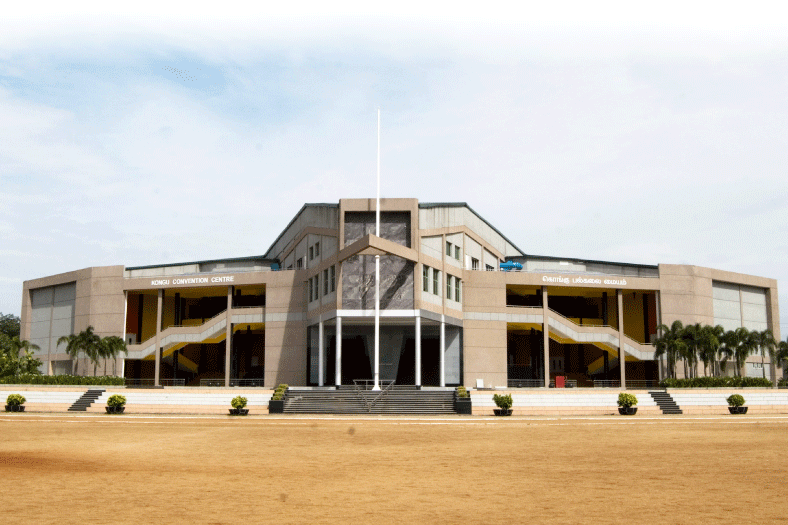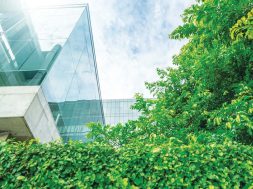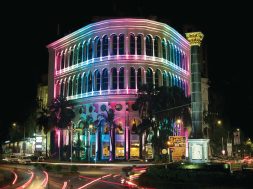Aluminium façades for enhanced building performance

Integral to every building, the aluminium façade is not only the outward face that the structure presents to the world, but also the statement that this face makes to those both inside and out. The ease and economics of construction of the aluminium façades, as well as lifespan and environmental responsibility are equally important.
The building façade or envelop is a filter between the climate outside and the conditioned space inside which determines the appearance of the building and its performance, opines Dr SP Anchuri, Chief Consultant, Anchuri & Anchuri. “Clads is an ideal façade system as it protects your exteriors from all kinds of weather conditions. Façades also activate space, drawing out relationships between light, environment and view. Adding warmth and elegance, façades are designed through studies in transparency,” says Parul Mittal, Director, Greenlam Industries Ltd.
Design and longevity of façade
It is very important to analyse the importance of a building’s façade and its impact on a building’s global performance and final value, Anchuri adds. According to him, a building has to address and control multiple loads and functions. Focusing only on climate-related loadings, a building and its enclosure experience different conditions or microclimates, depending on the project’s location, landscape, adjacent buildings, façade and roof configuration, among others. “This microclimate has to be taken into consideration when designing a façade solution. Modern design opportunities with traditional passive techniques can achieve longevity and low operating expenses in buildings post-occupation,” says Anchuri.
Prof. Charanjit Singh Shah, Founding Principal, along with Gurpreet Singh Shah, Principal Architect & Urban Designer, Creative Group are of the opinion that the conscious use of passive design features and use of materials can help in reducing a high proportion of the operating cost of the building, thus increasing its longevity. “With the intelligent use of the knowledge from solar movement and adopting it into the orientation of the building, we can reduce the use of artificial lighting within the building,” they further add.
Prem Nath, Chief Executive Officer, Prem Nath & Associates says that the most commonly used materials for cladding are stainless steel, zinc, copper and aluminium. Each of these metals has its own features and advantages. Façades can be finished with a wide array of materials and techniques. Exterior finishes can produce significant savings for the contractor and building occupant alike, and many options are available to protect from fire, extreme heat and cold.
Nath suggests that the materials used for façades be treated as long term investments, since most of these materials have a long life span. Materials like copper, whose technical lifespan is estimated at 100 years, are ideal for use in this context. Similarly, natural stones like granite and slate are very strong and impervious materials and have a very pleasing and natural aesthetic impact, while also being eco-friendly. The façade can be long-lasting if the correct material is installed in the right way. Stainless steel cladding, in particular, is a highly qualitative and sustainable solution to maintain the façade of a building throughout the years.
Surinder Bahga of Saakaar Foundation opines that design possibilities are guided by site, local bylaws, availability of local materials, budget, users, climate, etc. “Relevant information should be collected, analysed and then design solutions should be evolved,” says Bahga.
Boosting building performance
“The building envelope, particularly the façade, plays a crucial role on how the building performs during its lifetime and on how it addresses the long term weathering issues,” says Anchuri. Façades will greatly influence the value of a building as they determine aesthetics, protection against water and moisture, thermal efficiency, acoustic performance, natural lighting, indoor air quality, wind loads and durability.
Mittal is of the opinion that the weather and climate of an area play a major role in choosing a material which one might use for cladding. “However, there are universal materials that can be used in pretty much any conditions. Greenlam clads have a special protection surface on the outside that makes them suitable for not only any climate, but also for dust and acid rain which gives them a long life with minimal maintenance,” she adds.
According to Nath, the last twenty years have seen the rise of two very common façade types – glass and stone. When compared, the latter is simpler to design but the erection is time-consuming and maintenance is a true headache. Additionally, the system design of a stone-clad building envelope using the current system of anchors and clamps can be improved, particularly relating to aesthetics, design flexibility, lifecycle maintenance – by dry cladding. The dry cladding method creates a gap of around 30 to 45 mm in between the back wall and stone lining, providing a layer of air cushion that acts as a thermal barrier. The appearance of stone used in dry cladding work looks aesthetically pleasing.
Satisfactory weatherproofing of buildings is vital to maximising their design life and performance. A building’s performance must be taken into account since the beginning of its project stage. The analysis of a project’s variables and requirements determines which characteristics its solutions and elements need, in terms of efficiency and sustainability. Out of all the requirements, the large majority of them are related to the building’s façade. This is due to the fact that a building’s façade is its protection against the various atmospheric agents: sunlight, water, wind, etc. For instance, ventilation ensures that condensation will not be a problem in the building’s façade.
“A building with a stunning street presence is great, but beauty, as they say, is only skin-deep. A building envelope should not sacrifice its performance, and need not, with current design technologies. When it comes to a building’s exterior, there are three key aspects that will factor into its long-term operation: maintenance, energy conservation, and comfort,” Nath adds.
According to Bahga, there are many options which one can do for weather proofing to maintain thermal comfort and long life of buildings. Insulation in walls and roofs play pivotal role to protect the interiors of building from hot and cold conditions outside. Painting the building in white colour helps a lot in reflecting incident sunrays. As a result, the building receives 35 per cent lesser heat than that by using dark colours. “Cross-ventilation is also very important in buildings. Insulated AAC blocks, puff panels, hollow blocks, hollow roof tiles, etc, are important materials to make the buildings weather proof,” he says.
Latest design variants
“A modern façade must, by definition, cover all sections of the enclosure system,” says Anchuri. He goes on to say that the individual materials and components tend to take on less significance. “It is the overall performance of the system which is most important. The performance of a façade system can be totally undermined by the ‘weakest link’. The most common connection sealing details, on modern façades, are not standard details,” he adds.
Anchuri describes that at his firm, the design is such that it offers the perfect balance between the key criteria that will allow the stakeholders to achieve their goals on time, within budget and according to the defined quality standards. “In order to design and develop this solution, our façade engineer works closely with the manufacturers during solution prescription. A superior provider – partner – will ask, listen and present a solution with added value. Most of the time, it will be necessary to define and redefine the way out, develop an archetype, test it and finally endorse it,” says Anchuri.
“There are multiple options available these days to finish your exteriors like paint, stone, ACP, tile, compact HPL panel, etc. However, Greenlam clads is a new age façade cladding system for exteriors which is gaining popularity these days. These clads come in a variety of colours and designs which makes it possible to use Greenlam Clads for innovative applications like for main gates, pergolas, fencing and more,” says Mittal.
Nath is of the opinion that high pressure laminate (HPL) is the direct descendant of the original plastic laminate. It is considered to be one of the most durable decorative surface materials and is available with special performance properties including chemical, fire and wear resistance. Aluminium composite panel (ACP), also aluminium composite material (ACM), is a type of flat panel that consists of two thin aluminium sheets bonded to a non-aluminium core. Thin format ceramic is a porcelain product that fascinates with its sophisticated nuances that reach their fullest meaning through their unique qualities, exclusive to thin, large-format ceramic.
“Metal-based façade materials offer an extremely powerful and wide aesthetical range for use as architectural elements. Their technical properties are equally versatile, which is why our local experts are ready to help architects and developers in identifying good solutions to meet individual projects’ aesthetic, technical and economic conditions,” says Nath. He further adds that curtain-wall systems are typically designed with extruded aluminium members, although the first curtain walls were made of steel. The aluminium frame is typically in-filled with glass, which provides an architecturally pleasing building, as well as benefits such as day-lighting. Exterior insulation and finish system (EIFS) is a veneer system that insulates and can achieve a wide variety of looks. This material has been developed to replicate other materials in appearance.”
A façade is looked upon as the phizog of a building and is often seen as one of the most important design aspects. It not only protects the interior of a building from various climates, it is also the building’s main feature or frontage. Aluminium façades are commonly used on buildings all over the world.
Weather and climate of an area play a major role in choosing a material which one might use for cladding.
Parul Mittal, Director,
Greenlam Industries Ltd
With the intelligent use of the knowledge from solar movement and adopting it into the orientation of the building, we can reduce the use of artificial lighting within the building.
Prof. Charanjit Singh Shah, Founding Principal and Gurpreet Singh Shah, Principal Architect & Urban Designer, Creative Group
It is very important to analyse the importance of a building’s façade and its impact on a building’s global performance and final value.
Ar. SP Anchuri, Chief Consultant, Anchuri & Anchuri
When it comes to a building’s exterior, there are three key aspects that will factor into its long-term operation: maintenance, energy conservation and comfort.
Prem Nath, Chief Executive Officer, Prem Nath & Associates
Relevant information should be collected, analysed and then design solutions should be evolved.
Architect Surinder Bahga,
Saakaar Foundation
8
Cookie Consent
We use cookies to personalize your experience. By continuing to visit this website you agree to our Terms & Conditions, Privacy Policy and Cookie Policy.









